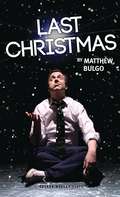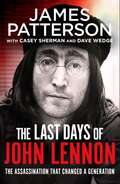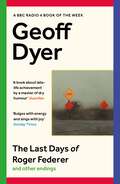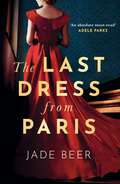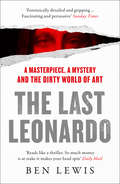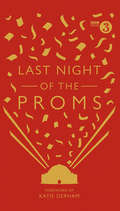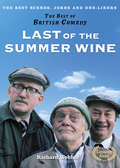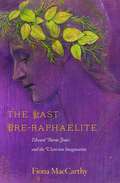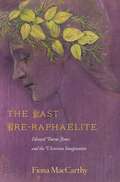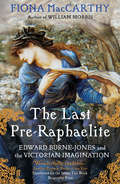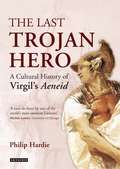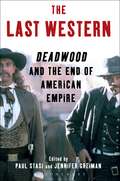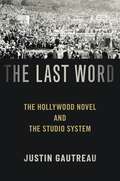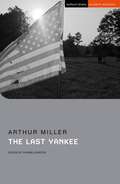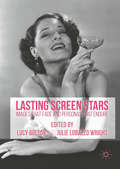- Table View
- List View
Last Christmas (Oberon Modern Plays)
by Matthew BulgoReturning home for Christmas, Tom is confronted with the ghosts of his past. Forced to face his demons, will he be able to rescue his family and his future in time? Forget panto and the dreaded office party, this one man show from Matthew Bulgo will make you laugh, cry and leave the theatre wanting to call your loved ones. A hit at the Edinburgh Festival Fringe, Matthew Bulgo’s witty and pacy script leaves audiences uplifted and heartbroken.
The Last Days of John Lennon
by James PattersonThe greatest true-crime story in music history.A GLOBAL SUPERSTARIn the summer of 1980, ten years after the break-up of the Beatles, John Lennon signed with a new label, ready to record new music for the first time in years. Everyone was awestruck when Lennon dashed off '(Just Like) Starting Over'. Lennon was back in peak form, with his best songwriting since 'Imagine'.A DANGEROUSLY OBSESSED FANIn the years after Lennon left the Beatles, becoming a solo artist and making a life with Yoko Ono in New York City, Mark David Chapman had become fixated on murdering his former hero. He was convinced that Lennon had squandered his talent and betrayed his fans. In December 1980, Chapman boarded a flight from Hawaii to New York with a handgun stowed in his luggage. He was never going home again. A MURDER THAT STUNNED THE WORLDEnriched by exclusive interviews with Lennon's friends and associates, including Paul McCartney, The Last Days of John Lennon is a true-crime drama about two men who changed history. One whose indelible songs enliven our world to this day, and the other who ended the music with five pulls of a trigger.
The Last Days of Roger Federer: And Other Endings
by Geoff Dyer'Quite possibly the best living writer in Britain' Daily Telegraph Much attention has been paid to so-called late style – but what about last style? When does last begin? How early is late? When does the end set in? In this endlessly stimulating investigation, Geoff Dyer sets his own encounter with late middle age against the last days and last achievements of writers, painters, athletes and musicians who’ve mattered to him throughout his life. With a playful charm and penetrating intelligence, he examines Friedrich Nietzsche’s breakdown in Turin, Bob Dylan’s reinventions of old songs, J.M.W. Turner’s paintings of abstracted light, John Coltrane’s cosmic melodies, Jean Rhys’s return from the dead (while still alive) and Beethoven’s final quartets – and considers the intensifications and modifications of experience that come when an ending is within sight. Oh, and there’s stuff about Roger Federer and tennis too. This book on last things – written while life as we know it seemed to be coming to an end – is also about how to go on living with art and beauty, on the entrancing effect and sudden illumination that an Art Pepper solo or an Annie Dillard reflection can engender in even the most jaded sensibilities. Blending criticism, memoir and repartee into something entirely new, The Last Days of Roger Federer is a summation of Dyer’s passions and the perfect introduction to his sly and joyous work.
The Last Dress from Paris: A heartbreaking and sweeping historical novel
by Jade Beer'Kept me spellbound...You can practically feel the heaviness and sumptuousness of the velvet and other lush materials of the vintage gowns in your hands. Secrets and heartbreak come alive in this book I was unable to put down!' Reader review ⭐⭐⭐⭐⭐Each Dior dress tells a story... London, 2017: When her beloved grandmother, Sylvie, sends her to Paris to retrieve a dress she wore decades before, Lucille sees the perfect opportunity to briefly escape the pressures of her own life. But not everything is as it seems, and the long-buried secrets she discovers, hidden in a collection of priceless Dior gowns, could change everything. Paris, 1952: Postwar France is full of glamour and privilege, and Alice Ainsley is in the middle of it all. As the wife to the British ambassador to France, her life is a whirlwind of jewels, banquets and couture dresses, but beneath the glittering facade, Alice is suffocating in a loveless marriage. So when a new face appears in her drawing room, Alice finds herself yearning to follow her heart . . . no matter the consequences. Deliciously evocative and achingly romantic, sweeping from Fifties Paris to the V&A museum in London, The Last Dress from Paris is the perfect read for fans of Taylor Jenkins Reid, Natasha Lester, Fiona Valpy and Gill Paul.Don't miss the new novel from Jade Beer, The Palace Dressmaker, another sweeping tale of love, friendship and the power of fashion to shape our lives... Everyone is falling in love with The Last Dress from Paris:'I'm sipping on a calming cup of tea and dabbing my eyes with a tissue after finishing this book... An excellent read! I love the description of the dresses. Paris in the 1950's... Loved this book!' Reader review ⭐⭐⭐⭐⭐'I couldn't put it down. What a great story. Loved, laughed and cried while reading it' Reader review ⭐⭐⭐⭐⭐'A delightful story of unrequited love, haute couture fashion, friendship, and secrets!... I read this one late into the night... I enjoyed the descriptions of the dresses, as well as the scenic locations in Paris. Secrets were gradually revealed, right up to the satisfying conclusion' Reader review ⭐⭐⭐⭐⭐'I loved this book!!... Bittersweet and with a mystery at its heart... A great read!' Reader review ⭐⭐⭐⭐⭐'Some books stick with you throughout reading and after finishing it. This is one of those books!... When I tell you that I loved this book, I mean it!!... Fashion, forbidden love, heartbreak... I HIGHLY recommend this book' Reader review ⭐⭐⭐⭐⭐'A brilliant book that will stay with me for a long time... A thoroughly engrossing novel of strong love' Reader review ⭐⭐⭐⭐⭐ 'A delightful fashion treasure hunt involving some of my favourite Dior gowns... The dresses dance from the pages, and Paris is resplendently depicted' Natasha Lester 'A whirlwind tour through Paris, both past and present, the novel is a rich exploration of the power of female friendships and the true meaning of family. Moving and utterly enjoyable' Fiona Davis 'An absolute delight!... As original, elegant, and romantic as the Dior dresses the novel's mystery is woven around' Hazel Gaynor 'As beautifully stitched together as a couture gown... I loved it' Jessica Fellowes 'Sumptuous, evocative and dripping in Parisian elegance. A beautifully written page-turner' Kate Thompson 'My kind of read, with vintage couture gowns, Parisian elegance, and romance across the ages' Gill Paul
The Last Leonardo: The Secret Life Of The World's Most Expensive Painting
by Ben LewisIn 2017 the Salvator Mundi was sold at auction for $450m. But is it a real da Vinci? In a thrilling narrative built on formidable research, Ben Lewis tracks the extraordinary journey of a masterpiece lost and found, lied and fought over across the centuries.
Last Night of the Proms: An Official Miscellany
by Katie DerhamThe ultimate celebration of the world’s favourite classical knees-up!With a foreword from Katie DerhamEver since Sir Henry Wood’s Proms were first broadcast in 1927, Last Night has become an annual appointment for classical music lovers and is enjoyed by millions around the world. This first and official miscellany explores the history and traditions that have developed on the last night of the world’s biggest and longest-running classical music festival. Learn about the origins of the Proms and how it first got its name. Discover the stories behind iconic Last Night songs such as ‘Land of Hope and Glory’, ‘Jerusalem’ and ‘Fantasia on British Sea Songs’, and prepare to Prom with our dos and don’ts guide for Last Night Prommers.From flag waving and ‘Rule, Britannia’ to the most memorable conductors’ speeches, and the story of how the Proms survived the Blitz, Last Night of the Proms: An Official Miscellany, is the perfect tribute to a uniquely British institution.
Last of the Summer Wine (The Best of British Comedy)
by Richard WebberThe best jokes, gags and scenes from a true British comedy classic. ‘Do you reckon I’m in love with Mrs. Batty, or is it just sex?’ Compo
The Last Palace: Europe's Extraordinary Century Through Five Lives and One House in Prague
by Norman EisenWhen Norman Eisen moved into the US ambassador's residence in Prague, returning to the land his mother had fled after the Holocaust, he was startled to discover swastikas hidden beneath the furniture. From that discovery unspooled the captivating, twisting tale of the remarkable people who lived in the house before Eisen. Their story is Europe's, telling the dramatic and surprisingly cyclical tale of the endurance of liberal democracy: the optimistic Jewish financial baron who built the palace; the conflicted Nazi general who put his life at risk for the house during World War II; the first postwar US ambassador struggling to save both the palace and Prague from communist hands; the child star- turned-diplomat who fought to end totalitarianism; and Eisen's own mother, whose life demonstrates how those without power and privilege moved through history.The Last Palace chronicles the upheavals that have transformed the continent over the past century and reveals how we never live far from the past.
The Last Pre-Raphaelite: Edward Burne-Jones and the Victorian Imagination
by Fiona MacCarthyIn Fiona MacCarthy’s riveting account, Burne-Jones’s exchange of faith for art places him at the intersection of the nineteenth century and the Modern, as he leads us forward from Victorian mores and attitudes to the psychological, sexual, and artistic audacity that would characterize the early twentieth century.
The Last Pre-Raphaelite: Edward Burne-Jones and the Victorian Imagination
by Fiona MacCarthyIn Fiona MacCarthy’s riveting account, Burne-Jones’s exchange of faith for art places him at the intersection of the nineteenth century and the Modern, as he leads us forward from Victorian mores and attitudes to the psychological, sexual, and artistic audacity that would characterize the early twentieth century.
The Last Pre-Raphaelite: Edward Burne-Jones and the Victorian Imagination
by Fiona MacCarthyWinner of the James Tait Black Memorial Prize, this is the biography of celebrated nineteenth-century artist Edward Burne-Jones, who - with William Morris - connects Victorian and modern art.'A triumph of biographical art.' Independent'Magnificent.' Guardian 'Rarely are biographies both as authoritative and engaging as this.' Literary ReviewThe angels on our Christmas cards, the stained glass in our churches, the great paintings in our galleries - Edward Burne-Jones's work is all around us. The most admired British artist of his generation, he was a leading figure with Oscar Wilde in the aesthetic movement of the 1880s, inventing what became an iconic 'Burne-Jones look'. Widely recognised as the bridge between Victorian and modern art, he influenced not just his immediate circle but European artists such as Klimt and Picasso.In this gripping book, award-winning biographer Fiona MacCarthy dramatically re-evaluates his art and life - his battle against vicious public hostility, the romantic susceptibility to female beauty that would inspire his work but ruin his marriage, his ill health and depressive sensibility, and the devastating rift with his great friend and collaborator, William Morris, when their views on art and politics diverged. Blending new research with a fresh historical perspective, The Last Pre-Raphaelite tells the extraordinary story of Burne-Jones: a radical artist, landmark of Victorian society - and peculiarly captivating man.
Last Seen Alone: The heartpounding new thriller you won't be able to put down!
by Laura GriffinWith her signature breathless pacing and suspenseful twists and turns, 'Laura Griffin never fails to put me on the edge of my seat' (USA TODAY).If you love Karen Rose, Melinda Leigh and Lisa Gardner, you'll be gripped by Laura Griffin!'I love smart, sophisticated, fast-moving romantic thrillers and Laura Griffin writes them brilliantly' Jayne Ann Krentz'A pulse-pounding romantic thriller' Publishers Weekly.............................................................................................A missing victim. A merciless killer.Up-and-coming attorney Leigh Larson fights for victims of sexual extortion, harassment, and online abuse. She's laser-focused on her career and not afraid to go after the sleaziest targets to get payback for her clients. Austin homicide detective Brandon Reynolds is no stranger to midnight callouts, but his investigation of an abandoned car on a desolate road reveals an unusual crime scene. A pool of blood in the nearby woods suggests a brutal homicide. But where is the victim? The vehicle is registered to twenty-six-year-old Vanessa Adams, yet all Brandon finds inside is a smear of blood and a business card for Leigh Larson, attorney-at-law. Vanessa had hired Leigh just before her disappearance, but Leigh has no leads on who could have wanted her dead. Faced with bewildering evidence and shocking twists, Leigh and Brandon must work against the clock to chase down a ruthless criminal who is out for vengeance..............................................................................................Raves for Laura Griffin:'Desperate Girls is a nail-biting read from the very first page to the final, shocking twist. I could not put this book down' Melinda Leigh'Griffin pulls out all the stops in a phenomenal twist ending that will leave readers stunned' Publishers Weekly
Last Seen in Santorini (Miss Ashford Investigates #2)
by Vivian ConroyA gorgeous Greek island A stranger in a veil And a fatal fall from the cliffs…
The Last Storytellers: Tales from the Heart of Morocco
by Richard HamiltonMarrakech is the heart and lifeblood of Morocco's ancient storytelling tradition. For nearly a thousand years, storytellers have gathered in the Jemaa el Fna, the legendary square of the city, to recount ancient folktales and fables to rapt audiences. But this unique chain of oral tradition that has passed seamlessly from generation to generation is teetering on the brink of extinction. The competing distractions of television, movies and the internet have drawn the crowds away from the storytellers and few have the desire to learn the stories and continue their legacy. Richard Hamilton has witnessed at first hand the death throes of this rich and captivating tradition and, in the labyrinth of the Marrakech medina, has tracked down the last few remaining storytellers, recording stories that are replete with the mysteries and beauty of the Maghreb.
Last Train to Hilversum: A journey in search of the magic of radio
by Charlie ConnellyDespite the all-pervading influence of television ninety per cent of people in Britain still listen to the radio, clocking up over a billion hours of listening between us every week. It's a background to all our lives: we wake up to our clock radios, we have the radio on in the kitchen as we make the tea, it's on at our workplaces and in our cars. From Listen With Mother to the illicit thrill of tuning into pirate stations like Radio Caroline; from receiving a musical education from John Peel or having our imagination unlocked by Douglas Adams' The Hitchhiker's Guide to the Galaxy; from school-free summers played out against a soundtrack of Radio One and Test Match Special to more grown-up soundtracks of the Today programme on Radio 4 and the solemn, rhythmic intonation of the shipping forecast – in many ways, our lives can be measured in kilohertz.Yet radio is changing because the way we listen to the radio is changing. Last year the number of digital listeners at home exceeded the number of analogue listeners for the first time, meaning the pop and crackle and the age of stumbling upon something by chance is coming to an end. There will soon be no dial to turn, no in-between spaces on the waveband for washes of static, mysterious beeps and faint, distant voices. The mystery will be gone: we'll always know exactly what it is we're listening to, whether it's via scrolling LCD on our digital radios, the box at the bottom of our TV screen or because we've gone in search of a particular streaming station. And so, as the world of analogue listening fades, Charlie Connelly takes stock of the history of radio and its place in our lives as one of the very few genuinely shared national experiences. He explores its geniuses, crackpots and charlatans who got us to where we are today, and remembers its voices, personalities and programmes that helped to form who we are as individuals and as a nation. He visits the key radio locations from history, and looks at its vital role over the past century on both national and local levels. Part nostalgic eulogy, part social history, part travelogue, Last Train To Hilversum is Connelly's love letter to radio, exploring our relationship with the medium from its earliest days to the present in an attempt to recreate and revisit the world he entered on his childhood evenings on the dial as he set out on the radio journey of a lifetime.
The Last Trojan Hero: A Cultural History of Virgil's Aeneid
by Philip Hardie“I sing of arms and of a man: his fate had made him fugitive: he was the first to journey from the coasts of Troy as far as Italy and the Lavinian shores.” The resonant opening lines of Virgil's Aeneid rank among the most famous and consistently recited verses to have been passed down to later ages by antiquity. And after the Odyssey and the Iliad, Virgil's masterpiece is arguably the greatest classical text in the whole of Western literature. This sinuous and richly characterised epic vitally influenced the poetry of Dante, Petrarch and Milton. The doomed love of Dido and Aeneas inspired Purcell, while for T S Eliot Virgil's poem was 'the classic of all Europe'. The poet's stirring tale of a refugee Trojan prince, 'torn from Libyan waves' to found a new homeland in Italy, has provided much fertile material for writings on colonialism and for discourses of ethnic and national identity. The Aeneid has even been viewed as a template and a source of philosophical justification for British and American imperialism and adventurism. In his major new book Philip Hardie explores the many remarkable afterlives - ancient, medieval and modern - of the Aeneid in literature, music, politics, the visual arts and film.
The Last Western: Deadwood and the End of American Empire
by Paul Stasi Jennifer GreimanPerhaps the most sophisticated and complex of shows in HBO's recent history, Deadwood has surprisingly little coverage in our current scholarship. Grounding contemporary anxieties about race and class, domesticity and American exceptionalism in its nineteenth-century setting, Deadwood revises our understanding of a formative period for the American nation through a re-examination of one of the main genres through which this national story has been transmitted: the Western. With contributions from scholars in American studies, literature, and film and television studies, The Last Western situates Deadwood in the context of both its nineteenth-century setting and its twenty-first-century audience. Together, these essays argue for the series as a provocative meditation on both the state and historical formation of U.S. empire, examining its treatment of sovereign power and political legitimacy, capital accumulation and dispossession, racial and gender identities, and social and family structures, while attending to the series' peculiar and evocative aesthetic forms. What emerges from this collection is the impressive range of Deadwood's often contradictory engagement with both nineteenth and twenty-first century America.
The Last Western: Deadwood and the End of American Empire
by Paul Stasi Jennifer GreimanPerhaps the most sophisticated and complex of shows in HBO's recent history, Deadwood has surprisingly little coverage in our current scholarship. Grounding contemporary anxieties about race and class, domesticity and American exceptionalism in its nineteenth-century setting, Deadwood revises our understanding of a formative period for the American nation through a re-examination of one of the main genres through which this national story has been transmitted: the Western. With contributions from scholars in American studies, literature, and film and television studies, The Last Western situates Deadwood in the context of both its nineteenth-century setting and its twenty-first-century audience. Together, these essays argue for the series as a provocative meditation on both the state and historical formation of U.S. empire, examining its treatment of sovereign power and political legitimacy, capital accumulation and dispossession, racial and gender identities, and social and family structures, while attending to the series' peculiar and evocative aesthetic forms. What emerges from this collection is the impressive range of Deadwood's often contradictory engagement with both nineteenth and twenty-first century America.
The Last Word: The Hollywood Novel and the Studio System
by Justin GautreauThe Last Word argues that the Hollywood novel opened up space for cultural critique of the film industry at a time when the industry lacked the capacity to critique itself. While the young studio system worked tirelessly to burnish its public image in the wake of celebrity scandal, several industry insiders wrote fiction to fill in what newspapers and fan magazines left out. Throughout the 1920s and 1930s, these novels aimed to expose the invisible machinery of classical Hollywood cinema, including not only the evolving artifice of the screen but also the promotional discourse that complemented it. As likeminded filmmakers in the 1940s and 1950s gradually brought the dark side of the industry to the screen, however, the Hollywood novel found itself struggling to live up to its original promise of delivering the unfilmable. By the 1960s, desperate to remain relevant, the genre had devolved into little more than erotic fantasy of movie stars behind closed doors, perhaps the only thing the public couldn't already find elsewhere. Still, given their unique ability to speak beyond the institutional restraints of their time, these earlier works offer a window into the industry's dynamic creation and re-creation of itself in the public imagination.
LAST WORD C: The Hollywood Novel and the Studio System
by Justin GautreauThe Last Word argues that the Hollywood novel opened up space for cultural critique of the film industry at a time when the industry lacked the capacity to critique itself. While the young studio system worked tirelessly to burnish its public image in the wake of celebrity scandal, several industry insiders wrote fiction to fill in what newspapers and fan magazines left out. Throughout the 1920s and 1930s, these novels aimed to expose the invisible machinery of classical Hollywood cinema, including not only the evolving artifice of the screen but also the promotional discourse that complemented it. As likeminded filmmakers in the 1940s and 1950s gradually brought the dark side of the industry to the screen, however, the Hollywood novel found itself struggling to live up to its original promise of delivering the unfilmable. By the 1960s, desperate to remain relevant, the genre had devolved into little more than erotic fantasy of movie stars behind closed doors, perhaps the only thing the public couldn't already find elsewhere. Still, given their unique ability to speak beyond the institutional restraints of their time, these earlier works offer a window into the industry's dynamic creation and re-creation of itself in the public imagination.
The Last Yankee (Student Editions)
by Arthur Miller'When the play focuses on the self-entrapment of the characters, Mr. Miller can be tender as well as trenchant' NEW YORK TIMES Two strangers meet in a New England psychiatric clinic, each visiting their admitted, depressed wife: one is a humble carpenter with seven children, the other a successful businessman in a childless marriage; both have been forgotten by the promise of the American Dream.Described by Miller as 'a comedy about a tragedy', this one-act play highlights the devastating consequences for those who fail to achieve the purported riches of the American Dream; a reality many face.This Methuen Drama Student Edition is edited by Ciarán Leinster, with commentary and notes that explore the play's production history (including excerpts from an interview with director David Thacker) as well as the dramatic, thematic and academic debates that surround it.
The Last Yankee (Student Editions)
by Arthur Miller'When the play focuses on the self-entrapment of the characters, Mr. Miller can be tender as well as trenchant' NEW YORK TIMES Two strangers meet in a New England psychiatric clinic, each visiting their admitted, depressed wife: one is a humble carpenter with seven children, the other a successful businessman in a childless marriage; both have been forgotten by the promise of the American Dream.Described by Miller as 'a comedy about a tragedy', this one-act play highlights the devastating consequences for those who fail to achieve the purported riches of the American Dream; a reality many face.This Methuen Drama Student Edition is edited by Ciarán Leinster, with commentary and notes that explore the play's production history (including excerpts from an interview with director David Thacker) as well as the dramatic, thematic and academic debates that surround it.
Last Year at Betty and Bob's: An Adventure
by Sher DoruffLast Year at Betty and Bob’s: An Adventure is the second in a series of three novellas emerging from a writing practice that taps the cusp of consciousness between dreaming and waking. A storyline, or genealogy, tinted a shade of RGB red, is fashioned by thinking through the felt unthought of this between space — a fabulation, an anarchive of what passes through. Lucid dreaming of this type is rife with allusions to conceptual and material goings-on, manifesting in awkward imaginaries. The dream personas are rendered as complex character amalgams with nomadic ages, sexes, genders, and phenotypes. Occurrences of lived “fact” elide with a hallucinatory real as speculation. In An Adventure, a feral feminist artist collective, The Bettys, inhabit a timeless Arcades Project. This is their experiment in wild hypo-consumerism. The event of Red Betty’s fall generates the advent of a turn. A cleaving. The intra-play of personal politics and activist artistic practices is surreally suffused with attention to color, to life and death, to lightness and heaviness.
The Lasting Influence of the War on Postwar British Film
by M. BoyceMany of the most celebrated British films of the immediate post-war period (1945-55) seem to be occupied with "getting on" with life and offering distraction for postwar audiences. It is the time of the celebrated Ealing comedies, Hue and Cry (1946) and Kind Hearts and Coronets (1949), Dickens adaptations, and the most ambitious projects of the Archers. While the war itself is rarely mentioned in these films, the war and the conditions of postwar society lie at the heart of understanding them. While various studies have focused on lesser known realist films, few consider how deeply and completely the war affected British film. Michael W. Boyce considers the preoccupation of these films with profound anxieties and uncertainties about what life was going to be like for postwar Britain, what roles men and women would play, how children would grow up, even what it meant - and what it still means today - to be British.
Lasting Screen Stars: Images that Fade and Personas that Endure
by Lucy Bolton Julie Lobalzo WrightLasting Stars examines the issue of stardom and longevity and investigates the many reasons for the persistence or disappearance of different star personas. Through a selection of chapters that look at issues such as inappropriate ageing, national identity and physical characteristics, this book will be the first volume to consider in depth and breadth the factors that affect the longevity of film stardom.The range of stars includes popular stars who are approached from fresh angles (Brando, Loren), less popular stars whose lower-profiles than their peers may be surprising (Taylor, Shearer) and stars whose national identity is integral to their perception as they age (Riva, Bachchan, Pavor). There are stars from the beginning of Hollywood (Valentino, Reid) to the present day (Jolie), and those who made uneasy transitions between countries (Mason), ages (Ringwald) and industrial eras (Keaton). The book examines the range of factors that affect how star images endure, including appropriate and inappropriate ageing (Griffith), race (Ice Cube) and digital technologies (Lee).
